
Squamata is the largest order of reptiles, comprising lizards and snakes. With over 11,500 species, it is also the second-largest order of extant (living) vertebrates, after the perciform fish. Members of the order are distinguished by their skins, which bear horny scales or shields, and must periodically engage in molting. They also possess movable quadrate bones, making possible movement of the upper jaw relative to the neurocranium. This is particularly visible in snakes, which are able to open their mouths very wide to accommodate comparatively large prey. Squamates are the most variably sized living reptiles, ranging from the 16 mm (0.63 in) dwarf gecko to the 6.5 m (21 ft) reticulated python. The now-extinct mosasaurs reached lengths over 14 m (46 ft).

Amphisbaenia is a group of typically legless lizards, comprising over 200 extant species. Amphisbaenians are characterized by their long bodies, the reduction or loss of the limbs, and rudimentary eyes. As many species have a pink body and scales arranged in rings, they have a superficial resemblance to earthworms. While the genus Bipes retains forelimbs, all other genera are limbless. Recent phylogenetic studies suggest that they are nested within Lacertoidea, closed related to the lizard family Lacertidae. Amphisbaenians are widely distributed, occurring in North America, Europe, Africa, South America, Western Asia and the Caribbean. Most species are less than 6 inches (15 cm) long.

Leiosauridae is a family of iguanian lizards containing six genera and 34 species. The family is endemic to Central America and South America.

Liolaemidae are a family of iguanian lizards. They were traditionally included in the family Iguanidae as subfamily Liolaeminae, which some more recent authors prefer to delimit in a more restricted way. A common name for this group is liolaemids. Liolaemidae are typically herbivores that have a diet high in fruit. Because of this special diet, Liolaemidae have a larger small intestine when compared to other similar omnivorous and insectivorous lizards.

The Iguanidae is a family of lizards composed of the iguanas, chuckwallas, and their prehistoric relatives, including the widespread green iguana.

The genus Brachylophus consists of four extant iguanid species native to the islands of Fiji and a giant extinct species from Tonga in the South West Pacific. One of the extant species, B. fasciatus, is also present on Tonga, where it has apparently been introduced by humans.

Chalarodon is a genus of Malagasy terrestrial iguanian lizard. It was considered a monotypic genus, until in 2015 a second species, Chalarodon steinkampi, was recognised based on morphology and DNA sequence data. The common names of this genus include Chalarodon or Dangalia lizard.
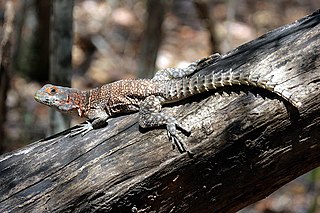
Oplurus is a genus of Malagasy iguanian lizards, most of which are rock-dwelling terrestrial species.
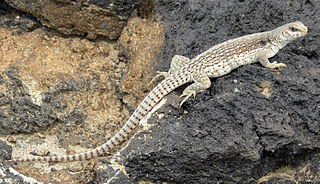
The desert iguana is an iguana species found in the Sonoran and Mojave Deserts of the Southwestern United States and northwestern Mexico, as well as on several Gulf of California islands.
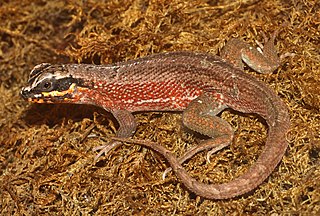
Iguania is an infraorder of squamate reptiles that includes iguanas, chameleons, agamids, and New World lizards like anoles and phrynosomatids. Using morphological features as a guide to evolutionary relationships, the Iguania are believed to form the sister group to the remainder of the Squamata, which comprise nearly 11,000 named species, roughly 2000 of which are iguanians. However, molecular information has placed Iguania well within the Squamata as sister taxa to the Anguimorpha and closely related to snakes. The order has been under debate and revisions after being classified by Charles Lewis Camp in 1923 due to difficulties finding adequate synapomorphic morphological characteristics. Most Iguanias are arboreal but there are several terrestrial groups. They usually have primitive fleshy, non-prehensile tongues, although the tongue is highly modified in chameleons. The group has a fossil record that extends back to the Early Jurassic. Today they are scattered occurring in Madagascar, the Fiji and Friendly Islands and Western Hemisphere.

Brachylophus fasciatus, the Lau banded iguana, is an arboreal species of lizard endemic to the Lau Islands of the eastern part of the Fijian archipelago. It is also found in Tonga, where it was probably introduced by humans. It is one of the few species of iguanas found outside of the New World and one of the most geographically isolated members of the family Iguanidae. Populations of these iguanas have been declining over the past century due to habitat destruction, and more significantly, the introduction of mongoose and house cats to the islands.

The fauna of Madagascar is a part of the wildlife of Madagascar.
In phylogenetics, basal is the direction of the base of a rooted phylogenetic tree or cladogram. The term may be more strictly applied only to nodes adjacent to the root, or more loosely applied to nodes regarded as being close to the root. Note that extant taxa that lie on branches connecting directly to the root are not more closely related to the root than any other extant taxa.
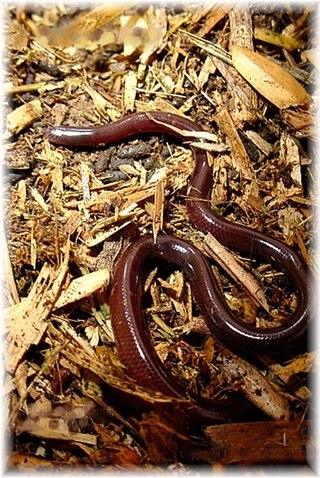
The Scolecophidia, commonly known as blind snakes or thread snakes, are an infraorder of snakes. They range in length from 10 to 100 centimetres. All are fossorial. Five families and 39 genera are recognized. The Scolecophidia infraorder is most likely paraphyletic.
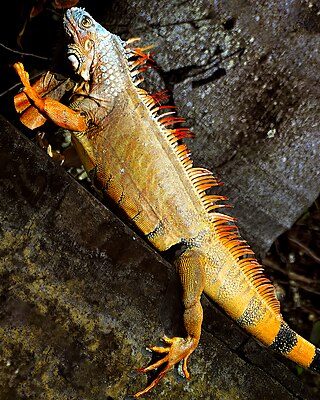
Iguana is a genus of herbivorous lizards that are native to tropical areas of Mexico, Central America, South America, and the Caribbean. The genus was first described in 1768 by Austrian naturalist Josephus Nicolaus Laurenti in his book Specimen Medicum, Exhibens Synopsin Reptilium Emendatam cum Experimentis circa Venena. Three species are placed in the genus: the green iguana, which is widespread throughout its range and a popular pet, the marine iguana and the Lesser Antillean iguana, which is native to the Lesser Antilles. Genetic analysis indicates that the green iguana may comprise a complex of multiple species, some of which have been recently described, but the Reptile Database considers all of these as subspecies of the green iguana.

Oceanic dispersal is a type of biological dispersal that occurs when terrestrial organisms transfer from one land mass to another by way of a sea crossing. Island hopping is the crossing of an ocean by a series of shorter journeys between islands, as opposed to a single journey directly to the destination. Often this occurs via large rafts of floating vegetation such as are sometimes seen floating down major rivers in the tropics and washing out to sea, occasionally with animals trapped on them. Dispersal via such a raft is sometimes referred to as a rafting event. Colonization of land masses by plants can also occur via long-distance oceanic dispersal of floating seeds.

Oplurus cuvieri, commonly known as the collared iguana, the collared iguanid lizard, Cuvier's Madagascar skink, Cuvier's Madagascar swift, and the Madagascan collared iguana, is a species of arboreal lizard in the family Opluridae. The species is native to Madagascar and Comoros. There are two recognized subspecies. O. cuvieri is the largest of six species in the genus Oplurus.

Oplurus quadrimaculatus, the Duméril's Madagascar Swift or Madagascar spotted spiny-tailed iguana, is a terrestrial malagasy iguana belonging to the family Opluridae.

Oplurus cyclurus, also known commonly as the Madagascar swift and Merrem's Madagascar swift, is a species of lizard in the family Opluridae. The species is endemic to Madagascar. It is arboreal and mostly insectivorous. Its breeding is timed with the rainy season.
Chalarodon steinkampi is a species of Malagasy terrestrial iguanian lizards. It was recognised as a new species in 2015, which is probably microendemic to a small area in south eastern Madagascar.




















